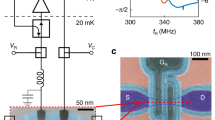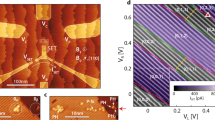Abstract
Electrical detection of spins is an essential tool for understanding the dynamics of spins, with applications ranging from optoelectronics1,2 and spintronics3, to quantum information processing4,5,6,7,8. For electron spins bound to donors in silicon, bulk electrically detected magnetic resonance has relied on coupling to spin readout partners such as paramagnetic defects4,5 or conduction electrons6,7,8, which fundamentally limits spin coherence times. Here we demonstrate electrical detection of donor electron spin resonance in an ensemble by transport through a silicon device, using optically driven donor-bound exciton transitions9,10. We measure electron spin Rabi oscillations, and obtain long electron spin coherence times, limited only by the donor concentration11. We also experimentally address critical issues such as non-resonant excitation, strain, and electric fields, laying the foundations for realizing a single-spin readout method with relaxed magnetic field and temperature requirements compared with spin-dependent tunnelling12,13, enabling donor-based technologies such as quantum sensing.
This is a preview of subscription content, access via your institution
Access options
Subscribe to this journal
Receive 12 print issues and online access
$259.00 per year
only $21.58 per issue
Buy this article
- Purchase on Springer Link
- Instant access to full article PDF
Prices may be subject to local taxes which are calculated during checkout




Similar content being viewed by others
References
Malissa, H. et al. Room-temperature coupling between electrical current and nuclear spins in OLEDs. Science 345, 1487–1490 (2014).
Algasinger, M. et al. Improved black silicon for photovoltaic applications. Adv. Energy Mater. 3, 1068–1074 (2013).
Appelbaum, I., Huang, B. & Monsma, D. J. Electronic measurements and control of spin transport in silicon. Nature 447, 295–298 (2007).
Stegner, A. R. et al. Electrical detection of coherent 31P spin quantum states. Nature Phys. 2, 835–838 (2006).
Paik, S. Y., Lee, S. Y., Baker, W. J., McCamey, D. R. & Boehme, C. T1 and T2 spin relaxation time limitations of phosphorus donor electron near crystalline silicon to silicon dioxide interface defects. Phys. Rev. B 81, 075214 (2010).
McCamey, D. R., van Tol, J., Morley, G. W. & Boehme, C. Electronic spin storage in an electrically readable nuclear spin memory with a lifetime >100 seconds. Science 330, 1652–1656 (2010).
Lo, C. C. et al. Electrically detected magnetic resonance of neutral donors interacting with a two-dimensional electron gas. Phys. Rev. Lett. 106, 207601 (2011).
Lo, C. C., Weis, C. D., van Tol, J., Bokor, J. & Schenkel, T. All-electrical nuclear spin polarization of donors in silicon. Phys. Rev. Lett. 110, 057601 (2013).
Steger, M. et al. Quantum information storage for over 180s using donor spins in a 28Si “semiconductor vacuum”. Science 336, 1280–1283 (2012).
Saeedi, K. et al. Room-temperature qubit storage exceeding 39 minutes using ionized donors in 28Si. Science 342, 830–833 (2013).
Tyryshkin, A. M. et al. Electron spin coherence exceeding seconds in high-purity silicon. Nature Mater. 11, 143–147 (2012).
Morello, A. et al. Single-shot readout of an electron spin in silicon. Nature 467, 687–691 (2010).
Pla, J. J. et al. A single-atom electron spin qubit in silicon. Nature 489, 541–545 (2012).
Kane, B. A silicon-based nuclear spin quantum computer. Nature 393, 133–137 (1998).
Morton, J. J. L. et al. Solid-state quantum memory using the 31P nuclear spin. Nature 455, 1085–1088 (2008).
Taylor, J. et al. High-sensitivity diamond magnetometer with nanoscale resolution. Nature Phys. 4, 810–816 (2008).
Schmid, W. Auger lifetimes for excitons bound to neutral donors and acceptors in Si. Phys. Status Solidi B 84, 529–540 (1977).
Yang, A. et al. Simultaneous sub second hyper polarization of the nuclear and electron spins of phosphorus in silicon by optical pumping of exciton transitions. Phys. Rev. Lett. 102, 257401 (2009).
Haynes, J. R. Experimental proof of the existence of a new electronic complex in silicon. Phys. Rev. Lett. 4, 361 (1960).
Yang, A. et al. High-resolution photoluminescence measurement of the isotopic-mass dependence of the lattice parameter of silicon. Phys. Rev. B 77, 113203 (2008).
Wilson, D. K. & Feher, G. Electron spin resonance experiments on donors in silicon. III. Investigation of excited states by the application of uniaxial stress and their importance in relaxation processes. Phys. Rev. 124, 1068–1083 (1961).
Feher, G. Electron spin resonance experiments on donors in silicon. I. Electronic structure of donors by electron nuclear double resonance technique. Phys. Rev. 114, 1219–1244 (1959).
Kopf, A. & Lassmann, K. Linear Stark and nonlinear Zeeman coupling to the ground state of effective mass acceptors in silicon. Phys. Rev. Lett. 69, 1580–1583 (1992).
Hoehne, F., Dreher, L., Huebl, H., Stutzmann, M. & Brandt, M. S. Electrical detection of coherent nuclear spin oscillations in phosphorus-doped silicon using pulsed endor. Phys. Rev. Lett. 106, 187601 (2011).
Jiang, L. et al. Repetitive readout of a single electronic spin via quantum logic with nuclear spin ancillae. Science 326, 267–272 (2009).
Thorbeck, T. & Zimmerman, N. M. Formation of strain-induced quantum dots in gated semiconductor nanostructures. Preprint at http://arxiv.org/abs/1409.3549 (2014)
Yin, C. et al. Optical addressing of an individual erbium ion in silicon. Nature 497, 91–95 (2013).
Sleiter, D. et al. Quantum hall charge sensor for single-donor nuclear spin detection in silicon. New J. Phys. 12, 093028 (2010).
Fuhrer, A., Füchsle, M., Reusch, T. C. G., Weber, B. & Simmons, M. Y. Atomic-scale, all epitaxial in-plane gated donor quantum dot in silicon. Nano Lett. 9, 707–710 (2009).
Thewalt, M. L. W. & Rostworowski, J. A. Effects of uniaxial stress on the luminescence lines due to multiexciton complexes bound to phosphorus in silicon. Phys. Rev. Lett. 41, 808–812 (1978).
Acknowledgements
We thank A. M. Tyryshkin for useful discussions. This research is supported by the EPSRC through the Materials World Network (EP/I035536/1) and UNDEDD project (EP/K025945/1) as well as by the European Research Council under the European Community’s Seventh Framework Programme (FP7/2007-2013) through grant agreements No. 279781 (ERC) and 318397. Work at Princeton is supported by NSF through Materials World Network (DMR-1107606) and through the Princeton MRSEC (DMR-01420541). C.C.L. is supported by the Royal Commission for the Exhibition of 1851. J.J.L.M. is supported by the Royal Society.
Author information
Authors and Affiliations
Contributions
C.C.L., M.U., M.F.G-Z. and J.J.L.M. conceived and designed the experiments. M.L.W.T. and S.A.L. provided the silicon samples. M.U. fabricated the silicon device, and the experiments were carried out by C.C.L., M.U. and P.R. C.C.L. developed the strain model for D0X and J.M. performed the strain simulations. All authors discussed the results. C.C.L. and J.J.L.M. wrote the manuscript with input from all authors.
Corresponding author
Ethics declarations
Competing interests
The authors declare no competing financial interests.
Supplementary information
Supplementary Information
Supplementary Information (PDF 2058 kb)
Rights and permissions
About this article
Cite this article
Lo, C., Urdampilleta, M., Ross, P. et al. Hybrid optical–electrical detection of donor electron spins with bound excitons in silicon. Nature Mater 14, 490–494 (2015). https://doi.org/10.1038/nmat4250
Received:
Accepted:
Published:
Issue Date:
DOI: https://doi.org/10.1038/nmat4250
This article is cited by
-
Scaling silicon-based quantum computing using CMOS technology
Nature Electronics (2021)
-
Quantum guidelines for solid-state spin defects
Nature Reviews Materials (2021)
-
Simultaneous coherence enhancement of optical and microwave transitions in solid-state electronic spins
Nature Materials (2018)
-
A silicon-based surface code quantum computer
npj Quantum Information (2016)
-
Electronic structures and enhanced optical properties of blue phosphorene/transition metal dichalcogenides van der Waals heterostructures
Scientific Reports (2016)



